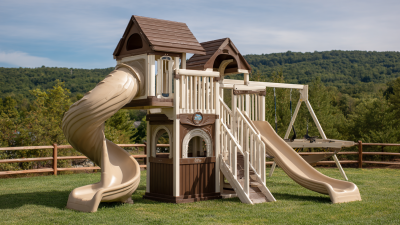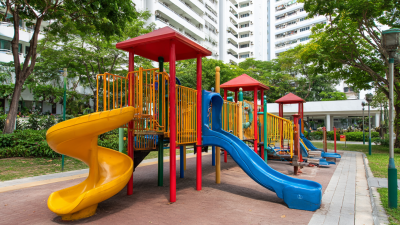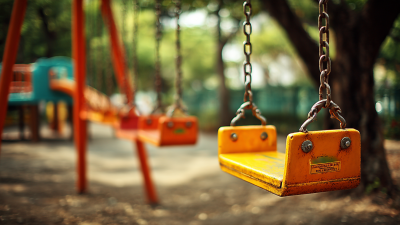 +86-13901441113
+86-13901441113




The "Outdoor Playground Swing" is not merely a piece of equipment; it serves as a powerful tool for child development and an avenue for endless fun. Swings provide children with an exhilarating sense of motion that stimulates their senses, enhances their physical coordination, and develops their core muscles. As children swing back and forth, they engage in a rhythmic motion that promotes balance and spatial awareness, essential skills as they grow.
 Beyond the physical benefits, outdoor swings also encourage social interaction, as children take turns and engage with peers, fostering communication skills and teamwork. The joy and laughter that accompany swinging create positive emotional experiences, contributing to a child's overall well-being. This article will delve into the multifaceted advantages of outdoor playground swings, illuminating how these simple structures can play a significant role in nurturing happy, healthy, and well-rounded children.
Beyond the physical benefits, outdoor swings also encourage social interaction, as children take turns and engage with peers, fostering communication skills and teamwork. The joy and laughter that accompany swinging create positive emotional experiences, contributing to a child's overall well-being. This article will delve into the multifaceted advantages of outdoor playground swings, illuminating how these simple structures can play a significant role in nurturing happy, healthy, and well-rounded children.
 Outdoor playground swings offer a multitude of benefits that significantly contribute to the physical development of children. According to the American Academy of Pediatrics, engaging in regular physical activity is crucial for children's growth, aiding in muscle development, coordination, and overall fitness. Swinging not only provides an exhilarating experience for children but also stimulates their vestibular system, which is essential for balance and spatial awareness. Research indicates that activities like swinging can enhance core strength and improve motor skills, serving as a playful workout that aligns with children's natural instincts for movement.
Outdoor playground swings offer a multitude of benefits that significantly contribute to the physical development of children. According to the American Academy of Pediatrics, engaging in regular physical activity is crucial for children's growth, aiding in muscle development, coordination, and overall fitness. Swinging not only provides an exhilarating experience for children but also stimulates their vestibular system, which is essential for balance and spatial awareness. Research indicates that activities like swinging can enhance core strength and improve motor skills, serving as a playful workout that aligns with children's natural instincts for movement.
Moreover, the benefits of swinging extend beyond physicality; it promotes social interaction and emotional well-being. A study by the National Association for Sport and Physical Education emphasizes that children who participate in interactive play, such as swinging with peers, develop crucial social skills and emotional resilience. This engaging activity encourages turn-taking and cooperative play, laying the foundation for teamwork and friendship. As children laugh and cheer while on swings, they experience not only the joy of movement but also the invaluable lessons of social connection, making swings a vital asset to any outdoor playground's design.
Swing play in outdoor playgrounds not only provides excitement and physical activity for children but also plays a pivotal role in enhancing their social skills. As children take turns swinging, they learn the importance of waiting, sharing, and cooperating with their peers. This interaction fosters a sense of community and helps children develop essential interpersonal skills that they will carry into their future relationships.
Moreover, swinging often leads to spontaneous social interactions. Children engaging in swing play are likely to initiate conversations, cheer each other on, and even negotiate play situations. These moments are crucial for developing emotional intelligence and empathy as they learn to understand and respond to the feelings of others. Through shared laughter and encouragement, children build friendships and learn to work through conflicts, laying the groundwork for effective communication skills. Overall, the simple act of swinging not only contributes to physical coordination and balance but also serves as a platform for richer social experiences.
Swinging is not just a delightful activity for children but also a vital component of their cognitive and physical development. As children engage with swings, they enhance their coordination and balance, two fundamental skills essential for various physical activities and everyday tasks. The dynamic movement involved in swinging challenges their bodies to stabilize and align, promoting muscle strength and reflexes. This process of coordination allows them to develop a better sense of spatial awareness, which is crucial for their overall cognitive growth.
Moreover, swinging stimulates the vestibular system, which plays a key role in balance and movement perception. As children swing back and forth, their brains receive important feedback about their body's position in space. This sensory input not only helps refine their balance but also encourages critical thinking and problem-solving skills as they learn to navigate their movements in a fun and engaging way. The rhythmic motion of swinging offers a unique learning experience, combining physical exertion with cognitive development, making outdoor playground swings a beneficial tool for fostering essential life skills in children.
 Outdoor playground swings offer incredible benefits that go beyond mere fun. They play a pivotal role in promoting emotional well-being and building confidence in children. As kids sway back and forth, they experience a sense of freedom and control, which can significantly boost their mood and self-esteem. This rhythmic motion not only calms anxious minds but also encourages children to push their limits, fostering resilience and a positive self-image.
Outdoor playground swings offer incredible benefits that go beyond mere fun. They play a pivotal role in promoting emotional well-being and building confidence in children. As kids sway back and forth, they experience a sense of freedom and control, which can significantly boost their mood and self-esteem. This rhythmic motion not only calms anxious minds but also encourages children to push their limits, fostering resilience and a positive self-image.
Tips for Encouraging Confidence on the Swings: Start by gently guiding your child on how to safely get on and off the swing. Make it a point to cheer for their small achievements, whether it's swinging higher or mastering basic swinging techniques. Allow them to swing independently to foster a sense of accomplishment and confidence.
Moreover, swing activities can serve as a social catalyst. Children often play together on swings, which enhances their social skills and emotional intelligence. Engaging in playful competitions or group games while swinging can help children learn important lessons about winning, losing, and teamwork.
Tips for Enhancing Social Interaction: Arrange playdates where children can take turns on swings, encouraging them to interact and communicate. Introduce games that involve swinging, like “swing tag,” to make the experience both fun and collaborative.
Outdoor swings are not just for swinging; they are gateways to imaginative adventures that can greatly benefit child development. When children engage in outdoor play, especially on swings, they are free to transform their surroundings into exciting worlds of creativity. A study from the American Academy of Pediatrics highlights that outdoor play can enhance cognitive skills by stimulating children's imaginations, fostering problem-solving abilities, and encouraging social interactions. Swings can serve as props in various pretend play scenarios: from being a spaceship soaring through the stars to a pirate ship sailing the high seas.
**Tips for Encouraging Imaginative Play on Swings:**
- Create themed playtime: Set a theme for the day (like "space exploration" or "undersea adventure") and encourage children to use their swings as imaginative vehicles for their adventures.
- Incorporate storytelling: Before swinging, narrate a short, imaginative story that involves swinging. Ask children how they would influence the story as they swing higher.
- Invite friends for group play: Encourage children to bring friends along to the swings, fostering collaborative play where they can build upon each other's ideas, expanding their imaginative adventures.
Emphasizing creative play through swings not only adds fun to outdoor activities but also nurtures essential developmental skills in a dynamic and engaging way.
| Dimension | Benefits | Play Ideas |
|---|---|---|
| Physical Development | Enhances coordination and balance | Swing races and obstacle courses |
| Social Skills | Encourages teamwork and sharing | Group swinging activities |
| Emotional Growth | Builds confidence and reduces anxiety | Imaginary play while swinging |
| Creative Thinking | Stimulates imagination through play | Storytelling swings and fantasy games |





